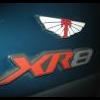HSV Clubsport R8
Price: $65,990 plus dealer and registration fees (same as before)
Engine: 6.2-litre LS3 V8 (same as before).
Power: 317kW at 6000rpm (same as before).
Torque: 550Nm at 4600rpm (same as before).
Transmission: Six-speed manual or six-speed auto adds $2000 (same as before).
Consumption, manual: 14.8L/100km (down from 15.1L/100km).
Consumption, auto: 13.9L/100km (down from 14.5L/100km).
What else is new:
New twin-nostril bonnet, matte black inserts, matte black hood header.
New HSV bonnet badge with carbonfibre background.
New front bumper with driving lights and LED daytime running lights.
New rear bumper, with rectangular exhaust tips.
New 19-inch wheel design.
Bosch 8.1 three-stage stability control: normal mode, competition mode, and off.
Bosch 8.1 launch control on manual models.
Bosch 8.1 cruise control with downhill brake assist.
Tyre pressure monitors.
Stronger clutch (from W427) on manual models.
Revised graphics (for competition mode) in digital instrument display.
Auto-up power windows on all four doors.
What's optional:
Sports suspension package (lowers the car 10mm and uses unique shocks and springs) $1850.
Bi-modal exhaust system (louder at certain revs, quieter at others) $2290.
Leather interior and 20-inch pentagon wheels (with charcoal accenting and machined spokes) $3990.
Any of the above changes earn a red SV Enhanced badge on the boot lid.
20-inch pentagon wheels finished in original silver are available as a stand alone option for $2500 (no SV Enhanced badge with this option).
HSV Clubsport R8 Tourer (wagon)
Price: $66,990 plus dealer and registration fees (same as before)
Engine: 6.2-litre LS3 V8 (same as before).
Power: 317kW at 6000rpm (same as before).
Torque: 550Nm at 4600rpm (same as before).
Transmission: Six-speed manual or six-speed auto adds $2000 (same as before).
Consumption, manual: 14.8L/100km (down from 15.1L/100km).
Consumption, auto: 13.9L/100km (down from 14.5L/100km).
What else is new:
New twin-nostril bonnet, matte black inserts, matte black hood header.
New HSV bonnet badge with carbon-fibre background.
New front bumper with driving lights and LED daytime running lights.
New 19-inch wheel design.
Bosch 8.1 three-stage stability control: normal mode, competition mode, and off.
Bosch 8.1 launch control on manual models.
Bosch 8.1 cruise control with downhill brake assist.
Tyre pressure monitors.
Stronger clutch (from W427) on manual models.
Revised graphics (for competition mode) in digital instrument display.
Auto-up power windows on all four doors.
What's optional:
Bi-modal exhaust system (louder at certain revs, quieter at others) $2290.
Leather interior and 20-inch pentagon wheels (with charcoal accenting and machined spokes) $3990.
Any of the above changes earn a red SV Enhanced badge on the boot lid.
20-inch pentagon wheels finished in original silver are available as a stand alone option for $2500 (no SV Enhanced badge with this option).
HSV Maloo R8 (ute)
Price: $62,990 plus dealer and registration fees (same as before)
Engine: 6.2-litre LS3 V8 (same as before).
Power: 317kW at 6000rpm (same as before).
Torque: 550Nm at 4600rpm (same as before).
Transmission: Six-speed manual or six-speed auto adds $2000 (same as before).
Consumption, manual: 15.1L/100km (down from 15.6.L/100km).
Consumption, auto: 14.3L/100km (down from 14.5L/100km).
What else is new:
New twin-nostril bonnet, matte black inserts, matte black hood header.
New HSV bonnet badge with carbon-fibre background.
New front bumper with driving lights and LED daytime running lights.
New 19-inch wheel design.
Bosch 8.1 three-stage stability control: normal mode, competition mode, and off.
Bosch 8.1 launch control on manual models.
Bosch 8.1 cruise control with downhill brake assist.
Tyre pressure monitors.
Stronger clutch (from W427) on manual models.
Revised graphics (for competition mode) in digital instrument display.
Two audio speakers behind the seats and a subwoofer increase the speaker tally from four to seven.
Auto-up power windows on both doors.
Side and curtain airbags.
What's optional:
Bi-modal exhaust system (louder at certain revs, quieter at others) $2290.
Leather interior and 20-inch pentagon wheels (with charcoal accenting and machined spokes) $3990.
Either of the above changes earn a red SV Enhanced badge on the tailgate.
20-inch wheels are not available as a standalone option on this model.
HSV Senator Signature
Price: $82,990 plus dealer and registration fees (up $700)
Engine: 6.2-litre LS3 V8 (same as before).
Power: 317kW at 6000rpm (same as before).
Torque: 550Nm at 4600rpm (same as before).
Transmission: Six-speed automatic only.
Consumption: 13.9L/100km (down from 14.5L/100km).
What else is new:
New front bumper with fog lights and LED daytime running lights.
Larger grille and larger HSV logo, ringless for the first time.
New rear bumper, with rectangular exhaust tips.
New 19-inch wheel design.
Bosch 8.1 three-stage stability control: normal mode, competition mode, and off.
Bosch 8.1 cruise control with downhill brake assist.
Revised graphics (for MRC and competition mode) in digital instrument display.
Tyre pressure monitors.
Auto-up power windows on all four doors.
What's optional:
Bi-modal exhaust system (louder at certain revs, quieter at others) $2290.
The above change earns a red SV Enhanced badge on the boot lid.
20-inch pentagon wheels finished in original silver are available as a stand alone option for $2500 (no SV Enhanced badge with this option).
HSV GTS
Price: $80,990 plus dealer and registration fees (up $700)
Engine: 6.2-litre LS3 V8 (same as before).
Power: 325kW at 6000rpm (2.5 per cent or 8kW more than before).
Torque: 550Nm at 4600rpm (same as before).
Transmission: Six-speed manual or six-speed auto adds $2000 (same as before).
Consumption, manual: 14.8L/100km (down from 15.1L/100km).
Consumption, auto: 13.9L/100km (down from 14.5L/100km).
What else is new:
New twin-nostril bonnet, metallic black vent inserts, chrome hood header.
New HSV bonnet badge with carbon-fibre background.
New front bumper with metallic black centre section, driving lights and LED daytime running lights.
New rear bumper, with rectangular exhaust tips.
New 20-inch wheel design, with 8.5-inch wide front wheels (up from 8-inch).
Bosch 8.1 three-stage stability control: normal mode, competition mode, and off.
Bosch 8.1 launch control on manual models.
Bosch 8.1 cruise control with downhill brake assist.
Tyre pressure monitors.
Stronger clutch (from W427) on manual models.
Bi-modal exhaust system (louder at certain revs, quieter at others).
Revised graphics (for MRC and competition mode) in digital instrument display.
Auto-up power windows on all four doors.
What's optional:
Racing Yellow six-piston front brakes and four-piston rear brakes (hardware from W427) are a $3790 option.
With this option comes yellow GTS badges, yellow centre caps on the wheels, and the machined alloy wheels are finished with gloss black spokes instead of charcoal spokes for the regular GTS.
The bigger brakes also earn the GTS a yellow SV Enhanced badge on the boot lid.

NEW E2 SERIES MODEL BREAK DOWN
Started by karbie, Jan 28 2010 08:07 PM
#1

 Posted 28 January 2010 - 08:07 PM
Posted 28 January 2010 - 08:07 PM

#2

 Posted 24 May 2010 - 06:45 PM
Posted 24 May 2010 - 06:45 PM

Just read through the post, i have 1 question, in the first section about the r8 clubsport, you mentioned fuel consumtion, now my question is not poking the shit at you but in my expriance manuals are better on fuel than autos (unless you drive around in low gears giving the thing f#*king shit all the time)
"Consumption, manual: 14.8L/100km (down from 15.1L/100km).
Consumption, auto: 13.9L/100km (down from 14.5L/100km)."
my question is how are they getting the auto to do better in fuel consumtion than the manual without lossing proformance or horsepower, normall or at least in the "old school days" an auto would take away about 30% of a motors power, where a manual may only lose 10 - 15% in the power transfere.
Take my 5.0L manual eb xr8 as an example, totally stock other than twin pipe's and after market extrators, on the 1/4 mile it pulled 14.278 sec and dino'd in at 229 rwhp, an auto of the same year/make would be lucky to see 16 sec's on the 1/4 and around 190 - 200hp's at there rear.
i know for a fact im not going to get 30hp from having extractor sand new pipes as the motor and heads and cam are all factory, so maybe an extra 3-5hp as the extractors will flow better than the heads can, there not much use without an up grade, as the factory heads will resrict flow, which in turn resricts HP's.
Anyway i got off topic, i just want to know how holden are getting the better fuel consumtion from an auto, espially a 6.2L they must be down tuned big time to get those figures, or there have been some major advances in the ecu and gear boxes, from my understanding auto gear boxes work just how there always have with staills in them, i guess the advances in the computing side of it must help a great deal
its just a topic i find quite intresting
"Consumption, manual: 14.8L/100km (down from 15.1L/100km).
Consumption, auto: 13.9L/100km (down from 14.5L/100km)."
my question is how are they getting the auto to do better in fuel consumtion than the manual without lossing proformance or horsepower, normall or at least in the "old school days" an auto would take away about 30% of a motors power, where a manual may only lose 10 - 15% in the power transfere.
Take my 5.0L manual eb xr8 as an example, totally stock other than twin pipe's and after market extrators, on the 1/4 mile it pulled 14.278 sec and dino'd in at 229 rwhp, an auto of the same year/make would be lucky to see 16 sec's on the 1/4 and around 190 - 200hp's at there rear.
i know for a fact im not going to get 30hp from having extractor sand new pipes as the motor and heads and cam are all factory, so maybe an extra 3-5hp as the extractors will flow better than the heads can, there not much use without an up grade, as the factory heads will resrict flow, which in turn resricts HP's.
Anyway i got off topic, i just want to know how holden are getting the better fuel consumtion from an auto, espially a 6.2L they must be down tuned big time to get those figures, or there have been some major advances in the ecu and gear boxes, from my understanding auto gear boxes work just how there always have with staills in them, i guess the advances in the computing side of it must help a great deal
its just a topic i find quite intresting
#3

 Posted 26 May 2010 - 06:02 PM
Posted 26 May 2010 - 06:02 PM

#4

 Posted 13 June 2010 - 05:13 PM
Posted 13 June 2010 - 05:13 PM

I cant Allen as I don't have the answer to it. I was just trying to provide generalised information at the time so that the forums had something to read in them. But perhaps the answer lies within the ECU or your local Holden dealer??  I'm not sure so i'm not going to bother trying to explain.
I'm not sure so i'm not going to bother trying to explain.
Why Drink and Drive when you can Drift and Slide.....
#5

 Posted 13 June 2010 - 05:20 PM
Posted 13 June 2010 - 05:20 PM

Because its a slight change in fuel consumption between the 2 perhaps there is a slight power loss but not enough to make a real difference? or the document could just contain a typo? Just a little guess so that I can say that I did try to give you an answer 
I will search further to get you a correct answer.
I will search further to get you a correct answer.
Why Drink and Drive when you can Drift and Slide.....

 Sign In
Sign In Create Account
Create Account

 Back to top
Back to top














